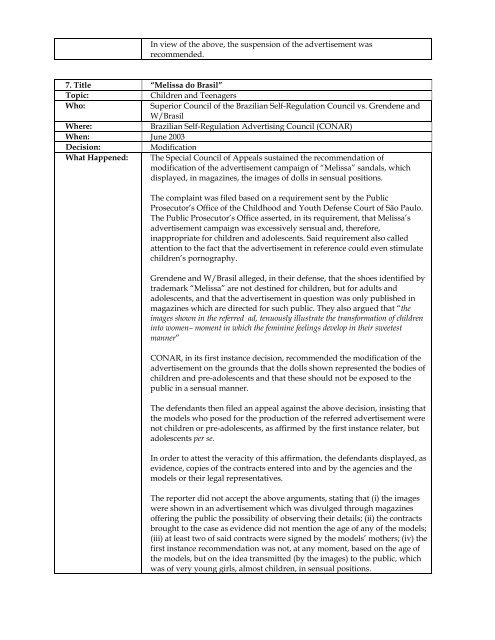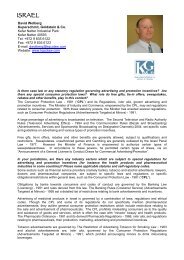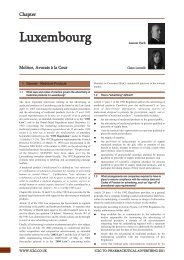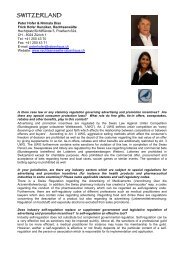list of contributors - GALA
list of contributors - GALA
list of contributors - GALA
Create successful ePaper yourself
Turn your PDF publications into a flip-book with our unique Google optimized e-Paper software.
In view <strong>of</strong> the above, the suspension <strong>of</strong> the advertisement was<br />
recommended.<br />
7. Title “Melissa do Brasil”<br />
Topic: Children and Teenagers<br />
Who: Superior Council <strong>of</strong> the Brazilian Self-Regulation Council vs. Grendene and<br />
W/Brasil<br />
Where: Brazilian Self-Regulation Advertising Council (CONAR)<br />
When: June 2003<br />
Decision: Modification<br />
What Happened: The Special Council <strong>of</strong> Appeals sustained the recommendation <strong>of</strong><br />
modification <strong>of</strong> the advertisement campaign <strong>of</strong> “Melissa” sandals, which<br />
displayed, in magazines, the images <strong>of</strong> dolls in sensual positions.<br />
The complaint was filed based on a requirement sent by the Public<br />
Prosecutor’s Office <strong>of</strong> the Childhood and Youth Defense Court <strong>of</strong> São Paulo.<br />
The Public Prosecutor’s Office asserted, in its requirement, that Melissa’s<br />
advertisement campaign was excessively sensual and, therefore,<br />
inappropriate for children and adolescents. Said requirement also called<br />
attention to the fact that the advertisement in reference could even stimulate<br />
children’s pornography.<br />
Grendene and W/Brasil alleged, in their defense, that the shoes identified by<br />
trademark “Melissa” are not destined for children, but for adults and<br />
adolescents, and that the advertisement in question was only published in<br />
magazines which are directed for such public. They also argued that “the<br />
images shown in the referred ad, tenuously illustrate the transformation <strong>of</strong> children<br />
into women– moment in which the feminine feelings develop in their sweetest<br />
manner”<br />
CONAR, in its first instance decision, recommended the modification <strong>of</strong> the<br />
advertisement on the grounds that the dolls shown represented the bodies <strong>of</strong><br />
children and pre-adolescents and that these should not be exposed to the<br />
public in a sensual manner.<br />
The defendants then filed an appeal against the above decision, insisting that<br />
the models who posed for the production <strong>of</strong> the referred advertisement were<br />
not children or pre-adolescents, as affirmed by the first instance relater, but<br />
adolescents per se.<br />
In order to attest the veracity <strong>of</strong> this affirmation, the defendants displayed, as<br />
evidence, copies <strong>of</strong> the contracts entered into and by the agencies and the<br />
models or their legal representatives.<br />
The reporter did not accept the above arguments, stating that (i) the images<br />
were shown in an advertisement which was divulged through magazines<br />
<strong>of</strong>fering the public the possibility <strong>of</strong> observing their details; (ii) the contracts<br />
brought to the case as evidence did not mention the age <strong>of</strong> any <strong>of</strong> the models;<br />
(iii) at least two <strong>of</strong> said contracts were signed by the models’ mothers; (iv) the<br />
first instance recommendation was not, at any moment, based on the age <strong>of</strong><br />
the models, but on the idea transmitted (by the images) to the public, which<br />
was <strong>of</strong> very young girls, almost children, in sensual positions.
















